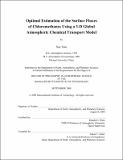Optimal estimation of the surface fluxes of chloromethanes using a 3-D global atmospheric chemical transport
Author(s)
Xiao, Xue, Ph. D. Massachusetts Institute of Technology
DownloadFull printable version (2.048Mb)
Other Contributors
Massachusetts Institute of Technology. Dept. of Earth, Atmospheric, and Planetary Sciences.
Advisor
Ronald G. Prinn.
Terms of use
Metadata
Show full item recordAbstract
The four chloromethanes - methyl chloride (CH3Cl), dichloromethane (CH2Cl2), chloroform (CHCl3), and carbon tetrachloride (CCl4), are chlorine-containing gases contributing significantly to stratospheric ozone depletion and having adverse health effects. Large uncertainties in estimates of their source and sink magnitudes and temporal and spatial variations currently exist. GEIA inventories and other bottom-up emission estimates are used to construct a priori maps of surface fluxes of these species. The Model of Atmospheric Transport and CHemistry (MATCH), driven by NCEP interannually varying meteorological fields, is then used to simulate the trace gas mole fractions using the a priori emissions and to quantify the time series of sensitivities of tracer concentrations to different aseasonal, seasonal, and regional sources and sinks.We implement the Kalman filter (with the unit pulse response method) to estimate both constant (if applicable) and time-varying surface fluxes on regional/global scales at a monthly resolution for the three short-lived species between 2000-2004, and the continental industrial emissions and global oceanic sink for CCl4 at a 3-month resolution between 1996-2004. The high frequency observations from AGAGE, SOGE, NIES and NOAA/GMD HATS and other low frequency flask observations are used to constrain the source and sink magnitudes estimated as multiplying factors for the a priori fluxes and contained in the state vector in the Kalman filter. The CH3Cl inversion results indicate large CH3Cl emissions of 2240 ± 370 Gg yr-1 from tropical plants. The inversion implies greater seasonal oscillations of the natural sources and sink of CH3Cl compared to the a priori. Seasonal cycles have been derived for both the oceanic (for CHCl3 and CH2Cl2) and terrestrial (for CHCl3) sources, with summer maxima and winter minima emissions. Our inversion results show significant industrial sources of CH2Cl2 and CCl4 from the Southeast Asian region. Our inversions also exhibit the strong effects of the 2002/2003 globally wide-spread heat and drought conditions on the emissions of CH3Cl from tropical plants and global salt marshes, on the soil fluxes of CH3Cl and CHCl3, on the biomass burning sources of CH3Cl and CH2Cl2, and on the derived oceanic flux of CHCl3.
Description
Thesis (Ph. D.)--Massachusetts Institute of Technology, Dept. of Earth, Atmospheric, and Planetary Sciences, 2008. This electronic version was submitted by the student author. The certified thesis is available in the Institute Archives and Special Collections. Includes bibliographical references (p. 199-210).
Date issued
2008Department
Massachusetts Institute of Technology. Department of Earth, Atmospheric, and Planetary SciencesPublisher
Massachusetts Institute of Technology
Keywords
Earth, Atmospheric, and Planetary Sciences.